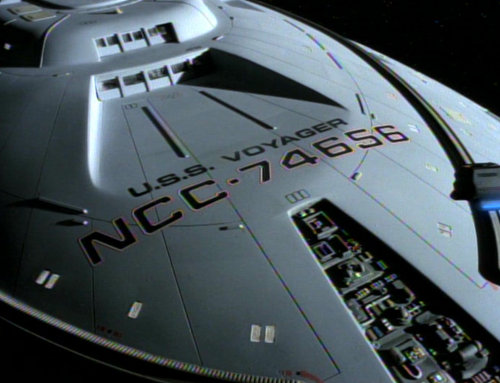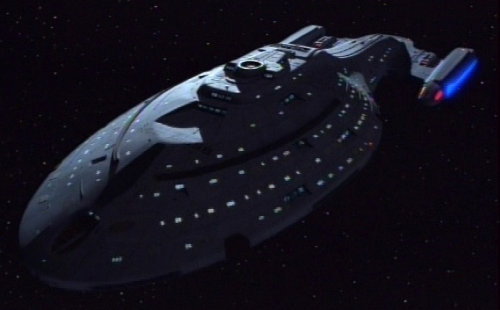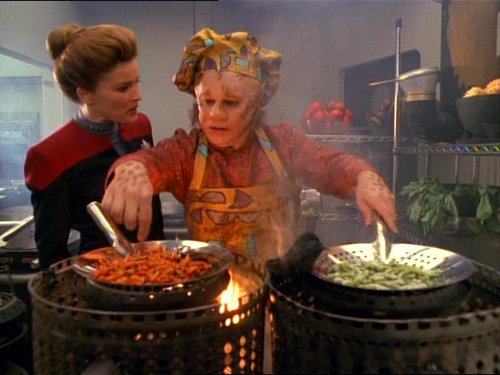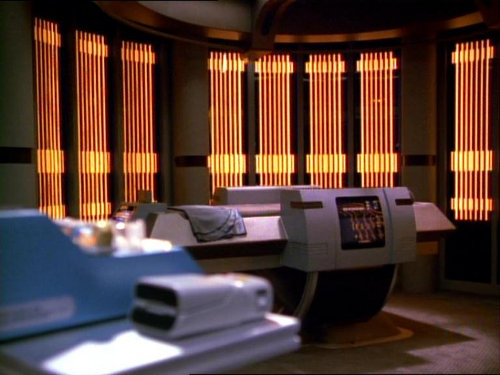U.S.S. Voyager NCC-74656 (First Splinter)
| Registry | NCC-74656 |
| Class | Intrepid |
| Commissioned | 2370 |
| First Appearance | VOY101-102 (16 Jan 1995) |
| Advertising |
The Federation Starship Voyager, an Intrepid class vessel, was launched in 2370 under the command of Captain Kathryn Janeway, and was stranded in the Delta Quadrant—some 70,000 light years from Earth—by an entity known as the Caretaker on SD48316.1. Captain Janeway invited the similarly stranded crew of a destroyed Maquis vessel—which Voyager was pursuing when it was pulled across the galaxy—to join the crew, and asked the Maquis commander, Chakotay, to serve as her first officer, succeeding the late Lieutenant Commander Cavit, who died in the violent transgalactic transit, while other members of the Maquis crew filled the positions of other Voyager crew members who had perished,[1] including B'Elanna Torres, who took over as Voyager's chief engineer.[2]
Construction
Voyager's computer core installation took place on SD47833.9; it was fast-tracked to follow the U.S.S. Intrepid NCC-74600 and the U.S.S. Bellerophon NCC-74705 by only three months. With assembly and internal systems checks completed, the official launching occurred at Earth Station McKinley on SD48039.7,[3] though primary construction was completed at Utopia Planitia Fleet Yards.[4] A 15-day series of impulse tests, which verified the integrity of the vessel and systems operation at sublight velocities, culminated in Voyager accelerating to Warp 1.03 with the U.S.S. Hauck flying formation for engineering support and emergency backup. Three weeks of warp flight tests added to the Intrepid class knowledge base and insured that Voyager's computer cores and bio-neural gel packs could receive operational programming loads for deployment in the Alpha Quadrant. Voyager received her first patrol assignment on SD48184.4. All in-flight systems data continued to be transmitted to Starfleet Command for evaluation, along a range of velocities from inertial stop to Warp 9.986 for distances up to 45 light years, with subspace com relays handling the encrypted telemetry loop. Subsequent operational missions validated the effectiveness of the class design and upgrades from previous Starfleet vessels. Voyager would provide only a few months of usable data before its disappearance in the Delta Quadrant. However, the stored information and lessons learned by its crew proved invaluable upon her return, a testament to the designers and engineers who stood upon the shoulders of giants to build her.[3]
Adaptations
Stranded in the Delta Quadrant, away from all the support facilities that Starfleet would have provided, Voyager's the crew was, by necessity, forced to make alterations to their vessel. These changes were designed to make the ship as self-sufficient as possible and to make it a suitable home for the journey back to the Alpha Quadrant, which was expected to last decades. Their problems were compounded because, unlike a Galaxy class starship, Voyager was not designed for extended missions.[5]
Shortly after its arrival in the Delta Quadrant, Voyager's engine efficiency began to decrease because of all the added demands being made upon the systems. Lieutenant Torres was able to realign the lateral plasma conduit without causing an overload, and this helped, but the engineering staff's attempts to convert power from the holodecks' independent reactors were unsuccessful. To conserve power, all security personnel on Deck 9 were relocated to Deck 7 and the power to Deck 9 was rerouted to propulsion. Lieutenant Tuvok admitted that this was inconvenient, but it was obvious that certain compromises had to be made. Other unused areas of the ship were also put on power conservation mode.[2]
U.S.S. Voyager galley (Template:VOY105)
Usage of all non-essential systems was minimized and, where possible, supplemented with power-efficient alternatives. Most significantly, Captain Janeway initiated a system of replicator rations. This necessitated the construction of a hydroponics garden in Cargo Bay 2, on Deck 8. The garden was initially supervised by Kes, who had previously grown plants in an artificially-sustained environment in the Ocampa city. Cargo Bay 2 was the ideal location for a hydroponics garden, since it was designed for organic storage and had an adjustable environment, which could be controlled to generate a variety of growing conditions. Kes set the garden up, and succeeded in growing a number of vegetables which supplemented replicated food.[2] Another cargo bay pulled double duty as a drill hall.[6] Restricting the use of the replicators also required modifications to the mess hall on Deck 2, where a galley was constructed from the captain's private dining room; modifying the galley was a complex process and required completely rerouting the mess hall power supply.[5]
U.S.S. Voyager sickbay (Template:VOY105)
Because Voyager's entire medical staff was killed, the Emergency Medical Hologram (EMH) was activated permanently, and eventually gained sentience. The Doctor's holographic nature, however, had several serious drawbacks. Most importantly, he was not designed to leave sickbay.[1] Attempts were made to install holographic projectors in essential locations around the ship, such as engineering and the main bridge, but these were unsuccessful; significantly, Lieutenant Torres and Ensign Harry Kim had trouble ensuring that the Doctor materialized at full size.[7] However, on a trip to the 20th century, the Doctor acquired a 29th-century portable holoemitter, which enabled his program to be activated away from the ship.[8] The EMH was only designed for emergency use, and further modifications were made to the Doctor's program to enable it to function indefinitely. After the program had been active for more than two years, it was merged with the EMH Diagnostic Program to extend its capactiy to absorb information and evolve a personality.[7]
Without access to starbases or other Federation facilities, Voyager was forced to develop services that would normally have been provided elsewhere. The crew began work on several engine design and modification projects, and the holodecks were used for extensive flight simulations, vital to the development of the groundbreaking transwarp engines fitted to the Shuttlecraft Cochrane.[9] They were also used in training exercises for some of the Maquis crew members who were not accustomed to Starfleet procedures.[6] And, with little chance of extended shore leave, it became common practice for large numbers of crew members share pleasurable holodeck environments such as Chez Sandrine[10] and the Paxau resort.[11]
Unlike other Starfleet ships, such as the U.S.S. Enterprise NCC-1701-D, which were equipped for long-range missions, Voyager was never intended to be a family ship. There were no facilities specifically designed for married couples, and the ship was not designed to house children. But with the prospect of such a long journey, the crew's quarters were restructured to provide for those crew members who had married and had children.[12]
The Borg also made significant upgrades to the ship when it passed through their space.[13] Many of these upgrades were designed to help the ship fight Species 8472, and most were later removed.[14] However, Cargo Bay 2 contained Borg equipment for several years thereafter, and Seven of Nine and Ensign Kim merged Borg and Starfleet technologies to enhance Voyager's astrometrics lab—a sophisticated navigational tool that was instrumental in plotting a shorter journey back to the Federation. The modified systems were ten times more accurate than the technology originally fitted to Voyager. The new astrometric sensors used the stars to navigate by measuring the radiative flux of up to three billion stars simultaneously, and the computer then calculated Voyager's position relative to the center of the galaxy. The upgraded system allowed the crew to plot a course for home that took five years off their original projected journey back to the Alpha Quadrant. The main screen could display everything from an overview of the entire galaxy to a specific region of a planet. These displays could be overlaid with charts, labels, and grids to show Voyager's most recent or projected course.[15] It could also be used as a conventional viewscreen to establish face-to-face communications.[16]
Return Home
In 2377, Voyager finally returned home, thanks to intervention from an alternate future version of Captain Janeway and a Borg transwarp hub.[17] Following Voyager's return, Janeway was promoted to admiral,[18] and command was transferred to Chakotay.[19]
Ships Named Voyager
Prime Timeline
Voyager series probes • U.S.S. Voyager NCC-74656 (Intrepid class) • U.S.S. Voyager NCC-74656-A (Lamarr class) • U.S.S. Voyager NCC-74656-B (Pathfinder class) • U.S.S. Voyager NCC-74656-J (Intrepid class (32nd Century))
Columbia Timeline
Voyager series probes • U.S.S. Voyager NCC-74656 (Intrepid class)
FASA Timeline
Voyager series probes • U.S.S. Voyager (Voyager class)
First Splinter Timeline
U.S.S. Voyager NCC-74656 (Intrepid class)
IDWM Timeline
I.S.S. Voyager NCC-74656 (Intrepid class)
LUG Timeline
Voyager series probes • U.S.S. Voyager NCC-74656 (Intrepid class)
STO Timeline
Voyager series probes • U.S.S. Voyager NCC-74656 (Intrepid class) • U.S.S. Voyager NCC-74656-J (Janeway class)
STOM Timeline
I.S.S. Voyager NCC-74656 (Intrepid class)
SVM Timeline
I.S.S. Voyager NCC-74656 (Intrepid class)
V201 Timeline
U.S.S. Voyager NCC-74656 (Intrepid class)
V271 Timeline
Intrepid class vessels
U.S.S. Bellerophon NCC-74705 • U.S.S. Intrepid NCC-74600 • U.S.S. Voyager NCC-74656
LUG Timeline
U.S.S. Blackthorne NCC-76719 • U.S.S. Gallant NCC-74882 • U.S.S. Intrepid NCC-74620 • U.S.S. Nelson NCC-74718 • U.S.S. Vanguard • U.S.S. Voyager NCC-74656 • U.S.S. Zealous NCC-74732
First Splinter Timeline
U.S.S. Pathfinder NCC-74562 • U.S.S. Sagan NCC-75055 • U.S.S. Stargazer NCC-2893-A • U.S.S. Voyager NCC-74656
STO Timeline
U.S.S. Bellerophon NCC-74705 • U.S.S. Intrepid NCC-74600 • U.S.S. Voyager NCC-74656
V201 Timeline
Notes and References
- ↑ 1.0 1.1 Berman, Rick & Piller, Michael & Taylor, Jeri (Executive Producers). "Caretaker." Star Trek: Voyager, Season 1, Episodes 1-2. Directed by Winrich Kolbe. Story by Rick Berman & Michael Piller & Jeri Taylor. Teleplay by Michael Piller & Jeri Taylor. Paramount Pictures Corporation, 16 January 1995.
- ↑ 2.0 2.1 2.2 Berman, Rick & Piller, Michael & Taylor, Jeri (Executive Producers). "Parallax." Star Trek: Voyager, Season 1, Episode 3 (Production 103). Directed by Kim Friedman. Story by Jim Trombetta. Teleplay by Brannon Braga. Paramount Pictures Corporation, 23 February 1995.
- ↑ 3.0 3.1 [[{{{author}}}|{{{author}}}]] (Writer). "USS Voyager". Star Trek: The Magazine, vol. 1 issue 4. Fabbri Publishing. August 1999.
- ↑ Berman, Rick & Brannon Braga (Executive Producers). "Relativity." Star Trek: Voyager, Season 5, Episode 23 (Production 218). Directed by Allan Eastman. Story by Nick Sagan. Teleplay by Bryan Fuller & Nick Sagan & Michael Taylor. Paramount Pictures, 12 May 1999.
- ↑ 5.0 5.1 Berman, Rick & Michael Piller & Jeri Taylor (Executive Producers). "Phage." Star Trek: Voyager, Season 1, Episode 5 (Production 105). Directed by Winrich Kolbe. Story by Timothy DeHaas. Teleplay by Skye Dent and Brannon Braga. Paramount Pictures, 6 February 1995.
- ↑ 6.0 6.1 Berman, Rick & Michael Piller & Jeri Taylor (Executive Producers). "Learning Curve." Star Trek: Voyager, Season 1, Episode 16 (Production 116). Directed by David Livingston. Written by Ronald Wilkerson and Jean Louise Matthias. Paramount Pictures, 22 May 1995.
- ↑ 7.0 7.1 Berman, Rick & Michael Piller & Jeri Taylor (Executive Producers). "The Cloud." Star Trek: Voyager, Season 1, Episode 6 (Production 106). Directed by David Livingston. Story by Brannon Braga. Teleplay by Tom Szollosi and Michael Piller. Paramount Pictures, 13 February 1995.
- ↑ Berman, Rick & Taylor, Jeri (Executive Producers). "Future's End, Part II." Star Trek: Voyager, Season 3, Episode 9. Directed by Cliff Bole. Written by Brannon Braga & Joe Menosky. Paramount Pictures Corporation, 13 November 1996.
- ↑ Berman, Rick & Piller, Michael & Taylor, Jeri (Executive Producers). "Threshold." Star Trek: Voyager, Season 2, Episode 15. Directed by Alexander Singer. Story by Michael De Luca. Teleplay by Brannon Braga. Paramount Pictures Corporation, 29 January 1996.
- ↑ Berman, Rick & Michael Piller & Jeri Taylor (Executive Producers). "Parallax." Star Trek: Voyager, Season 2, Episode 6 (Production 119). Directed by Kim Friedman. Story by Arnold Rudnick and Rich Hosek. Teleplay by Kenneth Biller. Paramount Pictures, 2 October 1995.
- ↑ Berman, Rick & Jeri Taylor (Executive Producers). "Warlord." Star Trek: Voyager, Season 3, Episode 10 (Production 152). Directed by David Livingston. Story by Andrew Shepard Price and Mark Gaberman. Teleplay by Lisa Klink. Paramount Pictures, 20 November 1996.
- ↑ Berman, Rick & Jeri Taylor (Executive Producers). "Mortal Coil." Star Trek: Voyager, Season 4, Episode 12 (Production 180). Directed by Allan Kroeker. Written by Bryan Fuller. Paramount Pictures, 17 December 1997.
- ↑ Berman, Rick & Jeri Taylor (Executive Producers). "Scorpion, Part II." Star Trek: Voyager, Season 4, Episode 1 (Production 169). Directed by Winrich Kolbe. Written by Brannon Braga & Joe Menosky. Paramount Pictures, 3 September 1997.
- ↑ Berman, Rick & Jeri Taylor (Executive Producers). "The Gift." Star Trek: Voyager, Season 4, Episode 2 (Production 170). Directed by Anson Williams. Written by Joe Menosky. Paramount Pictures, 10 September 1997.
- ↑ Berman, Rick & Jeri Taylor (Executive Producers). "Year of Hell, Part I." Star Trek: Voyager, Season 4, Episode 76 (Production 176). Directed by Allan Kroeker. Written by Brannon Braga & Joe Menosky. Paramount Pictures, 5 November 1997.
- ↑ Berman, Rick & Jeri Taylor (Executive Producers). "Message in a Bottle."Star Trek: Voyager, Season 4, Episode 14 (Production 181). Directed by Nancy Malone. Story by Rick Williams. Teleplay by Lisa Klink. Paramount Pictures Corporation, 21 January 1998.
- ↑ Berman, Rick & Biller, Kenneth (Executive Producers). "Endgame." Star Trek: Voyager, Season 7, Episodes 25 & 26 (Production 271-272). Directed by Allan Kroeker. Story by Rick Berman & Kenneth Biller & Brannon Braga. Teleplay by Kenneth Biller & Robert Doherty. Paramount Pictures Corporation, 23 May 2001.
- ↑ Berman, Rick (Producer). Star Trek: Nemesis. Directed by Stuart Baird. Story by John Logan & Rick Berman & Brent Spiner. Teleplay by John Logan. Paramount Pictures. 13 December 2002.
- ↑ Golden, Christie (Author). Homecoming. Star Trek: Voyager. Novel. Pocket Books. June 2003.




